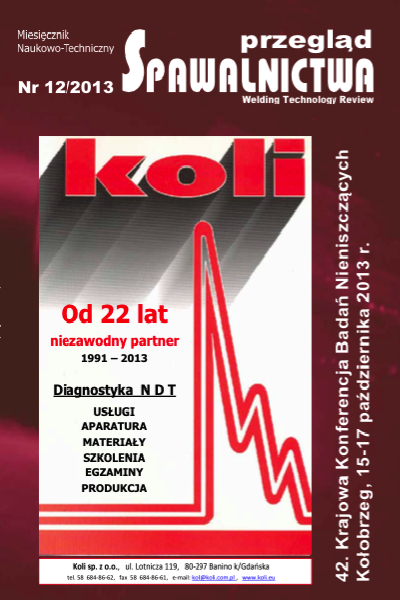Non-invasive inspection of heat exchanger tubes
Main Article Content
Abstract
Two well-known methods for inspection of tubes and pipes are Acoustic Pulse Reflectometry (APR) and Guided Waves (GW). Both are based on probing the tubes/pipes using long range acoustic waves, either through the air in the tubes (APR) or the tube walls (GW). Both methods share the advantage of being non-traversing, enabling very short inspection times, on the order of 10 seconds per tube. In addition, each method has complementary advantages and disadvantages. APR for example can de- tect blockages and very small pinholes but is in sensitive to Outer Diameter (OD) defects. GW, on the other hand, can detect OD faults but can not easily distinguish pitting from through-holes. As opposed to APR, which has been applied to tube inspection for several years, GW has been used mainly for screening applications in large diameter pipes. In this paper we firs present several recent developments in GW, giving an implementation that can fit into tubes as small as 3/4 and capable of detecting, classification and sizing of defects. We term this implementation Ultrasonic Pulse Reflectometry (UPR). We then show how a combined system containing both APR and UPR in a single probe provides a comprehensive solution to tube inspection, enabling very rapid inspection and capable of detecting all typical tube defects.
Bezinwazyjna metoda badania wymienników ciepła
Streszczenie
Dwie znane metody inspekcji rur i przewodów rurowych to Acoustic Pulse Reflectometry (APR) oraz GuidedWaves(GW). Obie metody oparte są na próbkowaniu rur/ przewodów za pomocą długich fal akustycznych, albo za pośrednictwem powietrza w rurach (APR) lub ścian rurowych(GW). Obie metody mają taką zaletę że, umożliwiają bardzo krótki czas kontroli, rzędu 10 sekund na rurę. Ponadto, każda z tych metod ma wady i zalety komplementarne. APR dla przykładu może wykryć blokad i bardzo małe kratery, ale jest niewrażliwa na wady na średnicy zewnętrznej (OD).Metoda GW, z drugiej strony, może wykryć błędy na średnicy zewnętrznej (OD), ale nie może z łatwością odróżnić wżerów od otworów przelotowych. W przeciwieństwie do APR, która jest stosowana do inspekcji rur przez kilka lat, GW był używany głównie do przesiewania aplikacji w rur o dużej średnicy. W tym artykule najpierw przedstawimy kilka wdrożeń i zastosowań GW, które mogą pasować do rurek tak małych, jak 3/4 i być zdolne do wykrywania, klasyfikacjii wielkości wad. Będzie to implementacja Ultrasonic Reflectometry Pulse(UPR). następnie pokażemy, jak łączyć układy zawierające zarówno APR oraz UPR w jed- no kompleksowe stanowisko do inspekcji rur, umożliwiające bardzo szybką kontrolę i zdolne do wykrywania wszystkich typowych uszkodzeń rur.
Downloads
Article Details
Creative Commons CC BY 4.0 https://creativecommons.org/licenses/by/4.0/
Welding Technology Review (WTR) articles are published open access under a CC BY licence (Creative Commons Attribution 4.0 International licence). The CC BY licence is the most open licence available and considered the industry 'gold standard' for open access; it is also preferred by many funders. This licence allows readers to copy and redistribute the material in any medium or format, and to alter, transform, or build upon the material, including for commercial use, providing the original author is credited.
References
I. Park, Y. Kim, S. Park, Y. Ahn, D. Gil, Application of ultrasonic guided wave to heat exchanger tubes inspection, 17th World Conference on nondestructive Testing, Shanghai, 2008.
E. S. Morgan, Experience with the Acoustic Rangera sound method for tube inspection, Proceedings of ASnT/CS- NDT conference, niagara Falls, 1979.
N. Amir, U. Shimony, and G. Rosenhouse, A Discrete Model for Tubular Acoustic Systems With Varying Cross Section— The Direct and Inverse Problems. Part 1: Theory, Acustica, 81, pp. 50462., 1995
N. Amir, O. Barzelay, A. Yefet, T. Pechter, Condenser Tube Examination Using Acoustic Pulse Reflectometry, J. Eng. Gas Turbines Power , Volume 132, Issue 1, 014501, DOI:10.1115/1.3125302, 2010
J. L. Rose, ‘‘A baseline and a vision of ultrasonic guided wave inspection potential, J. Pressure Vessel Technology, 124, 273-282, 2002.
T. Hayashi, M. Murase, Defect imaging with guided waves in a pipe, J. Acoust. Soc. Am., 117(4), 2134-2140, 2005.
